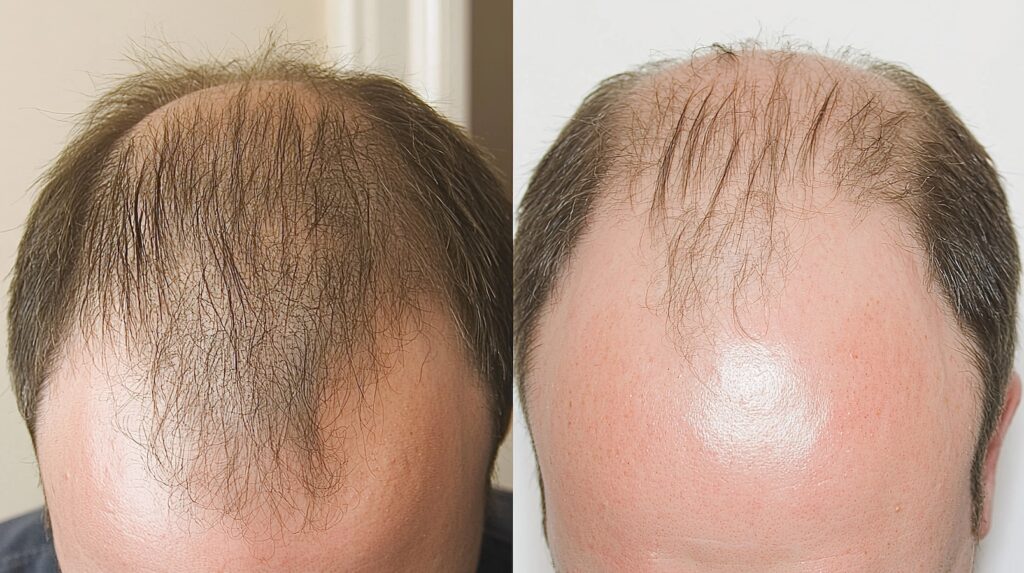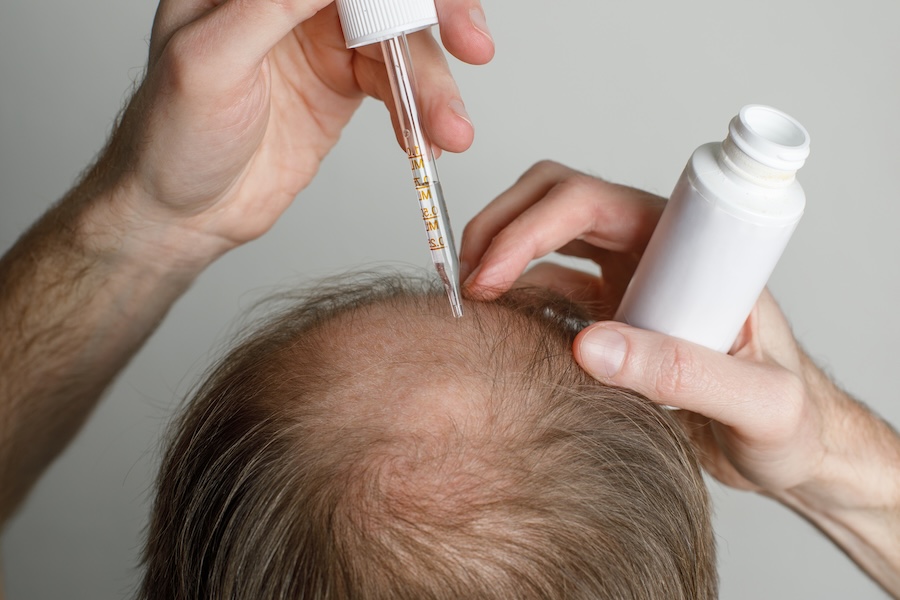Starting to lose your hair? You’re not alone. Millions of men suffer from male pattern baldness, a type of genetic hair loss that affects more than 80% of men by the time they’re 70 [1].
When you start to experience hair loss, it’s normal to wonder when (and if) it will stop. Unfortunately, this condition is progressive — most men go through several stages of male pattern baldness, resulting in widespread baldness.
So what are the stages of male pattern baldness, and how do professional trichologists measure your stage of hair loss? Here, you’ll learn:
- The causes and symptoms of male pattern baldness.
- The 7 stages of male pattern baldness and what they look like.
- How to recognise male pattern baldness.
- When and how to treat genetic hair loss.
Table of Contents
- What is male pattern baldness?
- What is the Norwood Scale?
- The stages of male pattern baldness
- Recognising the early stages of male pattern baldness
- Can you stop male pattern baldness progressing?
- At what stage should you start treating male pattern baldness?
- Get male pattern baldness treatments from DrHair
- FAQs
What is male pattern baldness?
Male pattern baldness is the most common type of hair loss worldwide [2]. It’s caused by a combination of your genes and dihydrotestosterone, a male sex hormone.
Dihydrotestosterone, or DHT, has many functions in your body, mostly relating to male sexual development. For example, it stimulates body and facial hair growth when you hit puberty. But it also has an impact on your hair.
DHT binds to receptors in your hair follicles. Over time, this makes your scalp follicles shrink (follicles elsewhere on your body, such as your face and chest, tend to be stimulated by DHT). As scalp hair follicles get smaller, they grow thinner hairs, until eventually they stop producing hair altogether. Your genes determine how sensitive you are to DHT, and how much DHT is in circulation at any given time.
Not all your follicles are sensitive to DHT. That’s why hair on the back and sides of your head continues to grow even as your hair thins on top. In most men, the affected follicles fall mainly along the hairline and crown, as well as across the top of the head — and usually in this order. This corresponds with the stages of male pattern baldness in the Norwood Scale.
What is the Norwood Scale?
The Norwood Scale — also known as the Hamilton-Norwood Scale — is the most common way to classify the stages of male pattern baldness. It’s used by professional trichologists to diagnose and measure male pattern hair loss.
The Norwood Scale consists of 7 distinct phases of hair loss:
Let’s take a closer look at each stage of the Norwood Scale, including how to recognise it and the most appropriate treatments.
The stages of male pattern baldness
There are 7 stages of male pattern baldness according to the Norwood Scale:
- Stage 1 — Healthy hair with virtually zero hair loss.
- Stage 2 — Light thinning around the temples and frontal hairline. No crown hair loss.
- Stage 3/3 vertex — Receding hairline becomes more obvious. Light thinning may start to appear on the crown.
- Stage 4 — More extensive thinning on the hairline and around the crown. Plenty of hair remains between the hairline and crown.
- Stage 5 — Substantial hair loss at the temples and crown. Still some density through the mid-scalp.
- Stage 6 — Hair loss at the temples, hairline, and crown meets, creating widespread baldness. Very little density through the mid-scalp.
- Stage 7 — Total baldness from the hairline to the crown. Only hair at the back and sides of the head remains.
Stage 1

Many younger men and older teenagers have hair at stage 1 of the Norwood Scale. This stage is characterised by a thick, full, straight hairline with virtually no thinning.
How to treat stage 1 hair loss
There’s not usually any treatment required at this stage. Using treatment unnecessarily may put you at risk of certain side effects with little benefit to your hair.
Stage 2

Hair that develops into stage 2 male pattern baldness is a little thinner around the temples and along the frontal hairline. Your hairline may become slightly uneven (or more uneven, as very few people have a naturally symmetrical hairline) if you lose more hair on one side.
How to treat stage 2 hair loss
Stage 2 is a good time to start thinking about using minoxidil to manage any initial hair loss. Minoxidil has minimal mild side effects and can help you retain your hair, particularly in the early stages of hair loss.
Stage 3/3 vertex

Stage 3 male pattern baldness is characterised by increased thinning through the temples, resulting in a highly visible receding hairline.
Some men also start to lose hair on the crown at this point. This begins as light thinning, but you will be able to see your scalp through the hair.
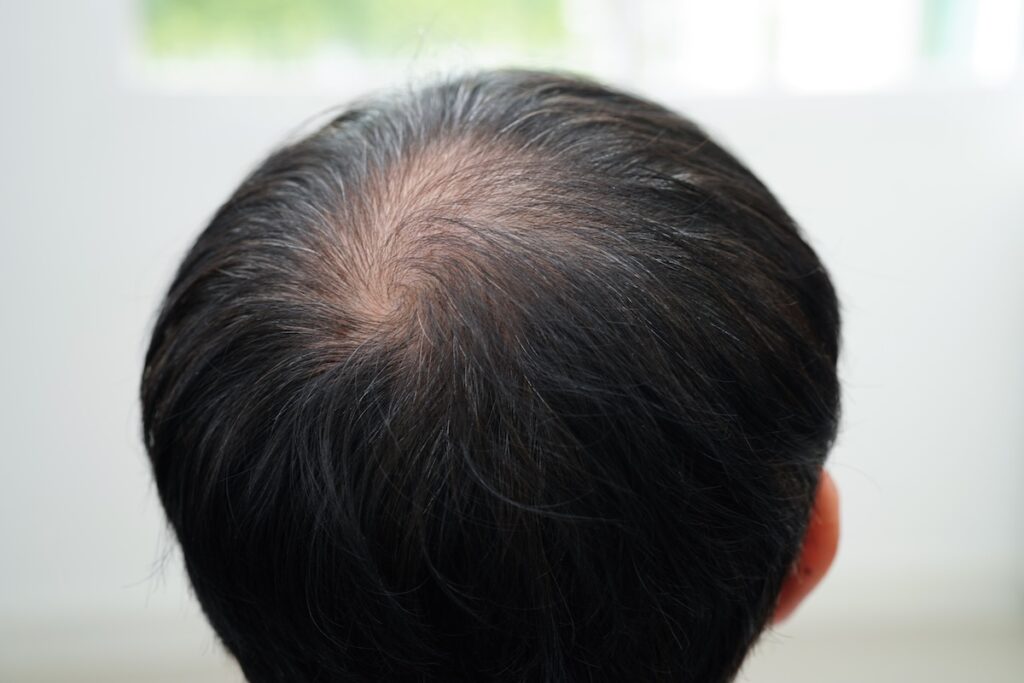
How to treat stage 3/3 vertex hair loss
At stage 3 of male pattern baldness, it’s a good idea to start taking finasteride if you’re concerned about hair loss. Taking 1mg finasteride once a day is proven to stop hair loss and can even regrow hair [3-4].
Stage 4

Increased hair loss at the temples results in a more extreme M-shaped hairline. If you also have crown hair loss, your bald spot will likely start to spread as you approach stage 4 of the Norwood Scale. But you’ll still have good coverage across the mid-scalp on top of your head.
How to treat stage 4 hair loss
Finasteride may still be very effective at stage 4 of male pattern baldness. You’re likely to see reduced hair loss and even increased regrowth if you take finasteride consistently for at least 3-6 months.
However, if your results have stalled or you want to maximise the impact of finasteride, consider using a supplementary treatment. Most men can safely combine finasteride with minoxidil [5]. Alternatively, consider using a derma roller or giving yourself a daily scalp massage to boost scalp blood flow.

Recommended
Finasteride (1mg) + Minoxidil 5% (60ml)
Inhibit DHT production to halt hair loss and promote hair growth.
Stage 5
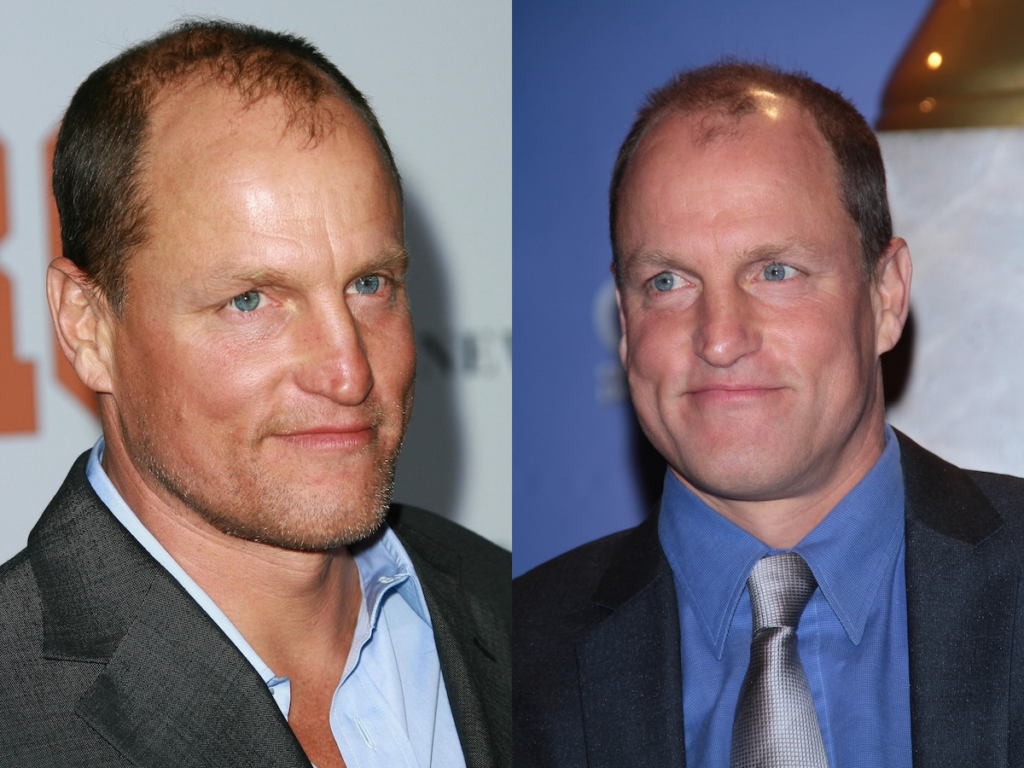
By stage 5, you’ll have substantial hair loss through the temples and crown. Coverage across the mid-scalp is also starting to thin, leaving you with a much sparser head of hair. Many men choose to shave their head at this point if treatment isn’t right for them.
How to treat stage 5 hair loss
Finasteride and minoxidil may help recover some of your lost hair at stage 5 of male pattern baldness, but you’re unlikely to get full regrowth. These treatments work best in the earlier stages of hair loss. A hair transplant supported by minoxidil and/or finasteride use can give you the best coverage, but using a combination of minoxidil and finasteride will give you the best chances of regrowth without surgery.
With the support of a doctor or trichologist, you may also want to explore off-label options, such as dutasteride. Dutasteride isn’t licensed for treating hair loss but studies have shown it is a highly effective oral treatment at low doses [6].
Stage 6
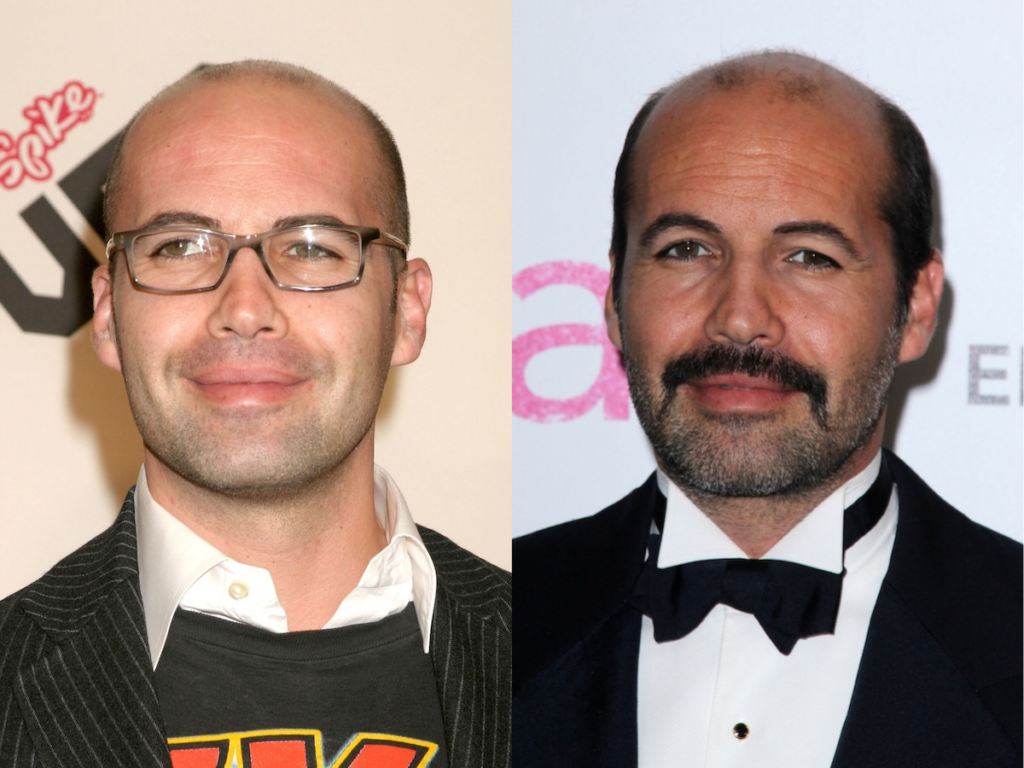
By stage 6, your hair loss is widespread, with very little coverage across the top of your head. You may still have some hair on the mid-scalp, but this is likely to be thin and sparse.
How to treat stage 6 hair loss
It’s more difficult to treat male pattern baldness at stage 6, as your hair loss is extensive and established by this point. A hair transplant may be necessary to recover your hair. Finasteride may also help you limit any further hair loss.
Stage 7

Stage 7 hair loss is characterised by complete loss of hair across the top of the head. You will still have some hair around the back and sides of your head, as these follicles are generally unaffected by male pattern baldness.
How to treat stage 7 hair loss
Stage 7 hair loss isn’t usually recoverable, though you may be able to add a little hair density with a high-graft hair transplant.
Recognising the early stages of male pattern baldness
Treatment for male pattern baldness works best in the early stages, so recognising the symptoms of early hair loss is important. Here’s what to look out for:
- Increased hair loss in the shower or on your pillow.
- Thinner hair at your temples.
- More hair loss on one side of your hairline.
- A developing M-shaped or U-shaped hairline.
If you’re unsure whether you have true hair loss, take a picture of your hairline. Then take another picture (in the same lighting) a few months later and compare them. Alternatively, look at older pictures of you from the last few months or years and compare your hair now and then. This should give you a better idea of whether you’re really losing hair.
Can you stop male pattern baldness progressing?
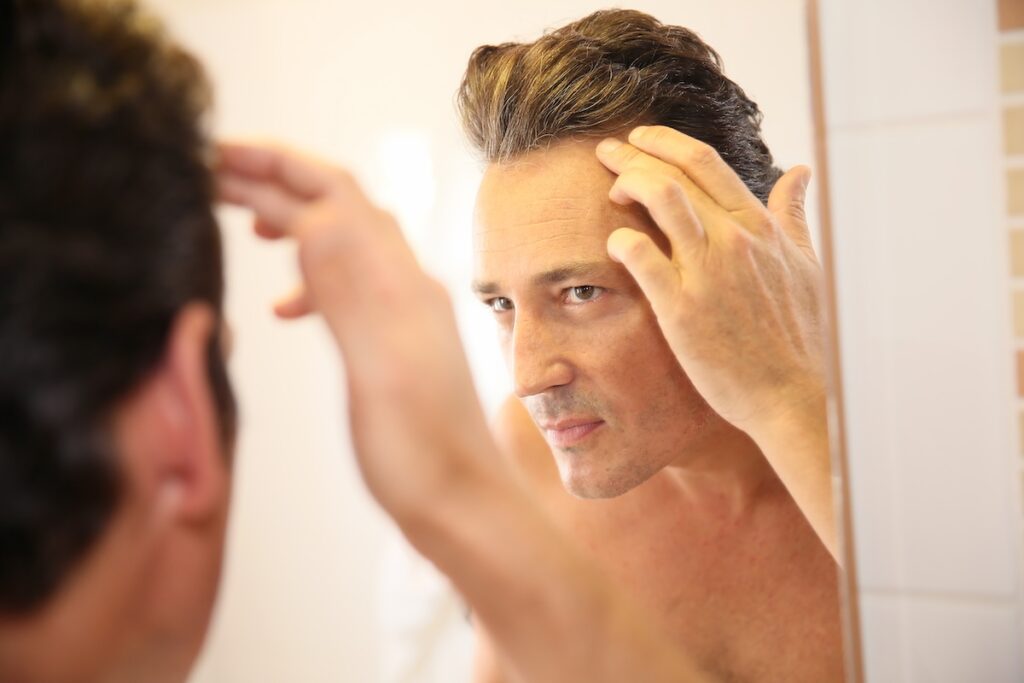
For some men, it takes decades for their hair loss to progress to the latter stages, while others see extensive balding within just a few years. But no matter how long it takes, male pattern baldness will continue to progress.
Fortunately, certain treatments can halt the progression of male pattern baldness, particularly if they’re used in the early stages. Both minoxidil and finasteride are licensed and proven to treat male pattern baldness.
At what stage should you start treating male pattern baldness?
For best results, you should start using a treatment for male pattern baldness as soon as you see the early signs of hair loss. This will give you the best chances of recovering your hair.
However, if you’re in the latter stages of male pattern baldness, all is not lost. You can still try these treatments to see their impact. A combination of finasteride and minoxidil is most likely to help slow thinning if you have more extensive hair loss. You may also need to consider off-label treatments or more invasive procedures, such as a hair transplant.
Get male pattern baldness treatments from DrHair
At DrHair, we’ve supplied online retailers and pharmacies with licensed hair loss treatments for more than 30 years. Our products are now available for individual users to buy directly from us, so we can offer the best price.
With DrHair, you’ll also get:
- Fast, discreet shipping
- Quick 1-minute assessment
- Discounted subscription prices
- One-month supplies with no subscription
- Friendly accessible customer service team
Take a look at our hair loss treatments and take our 1-minute assessment to stop your hair loss getting any further.
FAQs
Learn more about the development of male pattern baldness in these FAQs.
There’s no hard and fast rule about how long it takes for male pattern baldness to progress. Some men see a lot of hair loss early on, while for others the effects are much more drawn out. Research suggests it’s possible to go bald within 5 years, though for most men it takes 15 to 25 years [7].
You can look to other men in your family to see how your hair loss might progress, though there’s no guarantee your hair loss will resemble theirs.
Whether or not stage 4 hair loss can be reversed depends on your response to treatment. For the best chances, you’ll need to take a 1 mg dose of finasteride every day, and apply 1 ml of minoxidil to your scalp twice a day. Doing this consistently will give you the best chance of regrowth without resorting to more invasive measures.
In most cases, no — male pattern baldness typically starts along the frontal hairline. However, some men do see more balding on the crown than at the front of their hair.
Male pattern baldness can start at any age from around 16/17 onwards. However, for most men, the onset of male pattern baldness is between the ages of 20 and 25 [1].


